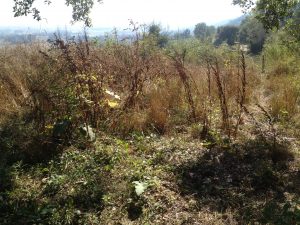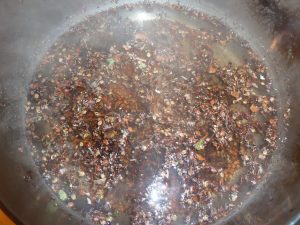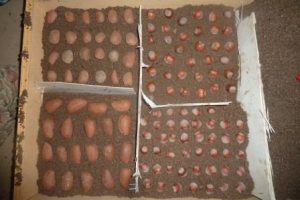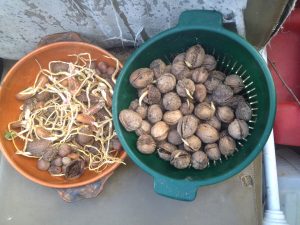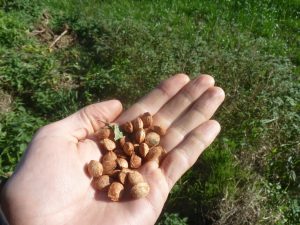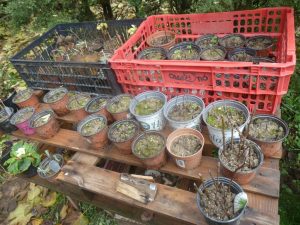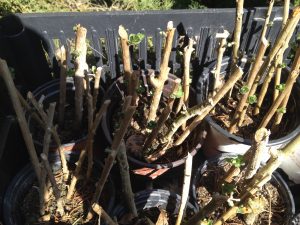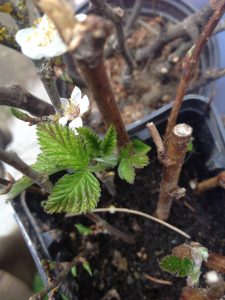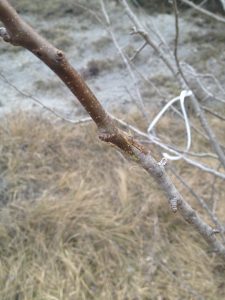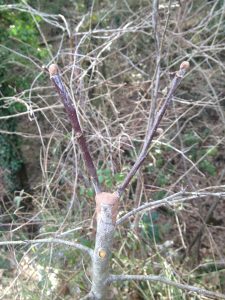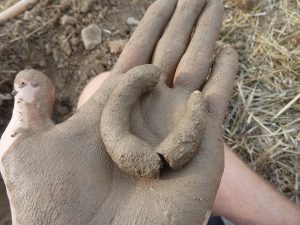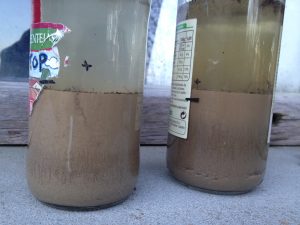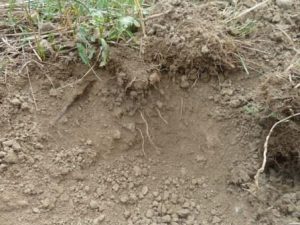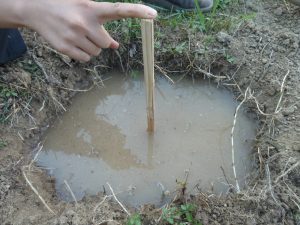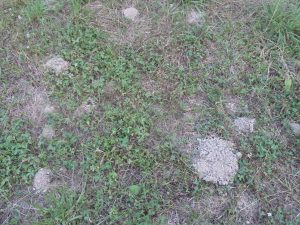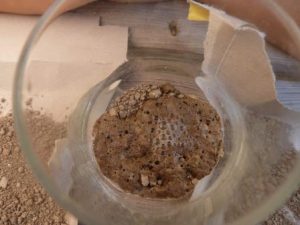It’s not an exhaustive list but it gives an idea of the diversity that we have in our forest garden project.
The latin names that are orange mean that these are plants that we found in the wild in Fontarnau. This is just a few examples of the wild plant we use for eating and medicinal purpose. In fact sharing about wild plants uses is really our passion. There is so much more plants that we can see as valuable ! In fact, any forest is already a food forest ! Here in fontarnau we can base our diet with plants with extraordinary nutritionnal value like oak (acorns), jerusalem artichoke, roots from lots of plants, especially from the Asteraceae family (Cirsium, Scorsonera, Tragopogon, Arctium spp. etc), leaves like nettlle, amaranth, fat-hen, etc.
We are a bit lazy still but the idea would be to have the name in latin/english/spanish/catalan/french, and to put always a little description of why we use each plants.
TREES
Quercus pubescens (syn. Quercus humilis). Downy Oak [en], Roble pubescente [es], Roure Martinenc [cat], Chêne pubescent [fr]. We collect the acorns that we cook a bit like chestnut. Very healthy and nutritive.
Quercus ilex. Holm Oak [en], Encina [es], Alzina [cat], Chêne vert [fr]. Edible acorns.
Tilia spp. Lime tree [en], Tilo [es], Til-ler [cat], Tilleuls [fr]. Edible leaves, flowers very good in medicine
Juglans regia: Walnut [en], Nogal [es], Noguera [cat], Noyer [fr]. Grow semi-wild here.
Arbutus unedo: Strawberry tree [en], Madroño [es], Arboç [cat], Arbousier [fr]
Prunus domestica: Plum tree [en], Ciruelo [es], Prunera [cat], Prunier [fr]. Grow semi-wild here.
Ficus carica: Fig tree [en], Higuera [es], Figuera [cat], Figuier [fr]. Grow semi-wild here.
Sorbus domestica: Service tree [en], Serbal [es], Servera [cat], Cormier [fr].
Prunus avium: Wild Cherry [en], Cerezo silvestre [es], Cirerer silvestre [cat], Merisier [fr]. Edible cherry (a bit small) and leaves. We also have domesticated forms.
Crataegus azerola: Azarole [en], Acerolo [es], Atzeroler [cat], Azerolier [fr].
Crataegus monogyna: Hawthorn [en], Espino [es], Arç blanc [cat], Aubépine [fr]. Good medicinal plant, the berry and the leaves can be eaten. Got rootstock, especially for medlar.
Diospyros kaki: Persimon [en], Caqui [es], Kaki [cat], Kaki/Plaqueminier [fr]
Malus domestica: Apple [en], Manzano [es], Pomera [cat], Pommier [fr]
Pyrus domestica: Pear [en], Peral [es], Perera/perer [cat], Poirier [fr]
Pyrus pyraster: Wild Pear [en], Peral silvestre [es], Perera silvestre [cat], Poirier sauvage [fr].
Mespilus germanica: Medlar [en], Nispero [es], Nespler [cat], Néflier [fr]
Eriobotrya japonica: Loquat [en], Nispero japonès [es], Nesprer del Japo [cat], Néflier du Japon/Bibacier [fr]
Ziziphus jujuba: Jujube [en], Azufaifo [es], Ginjoler [cat], Jujubier [fr]
Cydonia oblonga: Quince [en], Membrillo [es], Codonyer [cat], Cognassier [fr].
Prunus dulcis: Almond [en], Almendro [es], Atmetller [cat], Amandier [fr].
Coryllus avellana: Hazelnut [en], Avellano [es], Avellaner [cat], Noisetier [fr]. The leaves as well are edible.
Prunus armeniaca: Apricot tree [en], Albaricoque [es], Albercoquer [cat], Abricotier [fr]
Olea europaea: Olive tree [en], Olivo [es], Olivera [cat], Olivier [fr].
Punica granatum: Pomegranate [en], Granado [es], Magraner [cat], Grenadier [fr]
Acca sellowiana: Feijoa [en, es, cat, fr], guayabo del pais [es], Goyavier du Bresil [fr]
Etc…
Other interesting useful trees:
Acer spp. Maple [en]. Edible leaves.
Pinus sylvestris. Pine [en], Pino sylvestre [es], Pi Roig [cat], Pi sylvestre [fr]. Edible seed and buds; and you can make a bread out of the dry cambium (we never tried it yet).
Picea abies. European spruce [en], Picea comun [es], Avet roig [cat], Epicea [fr]. In spring, you can eat the young leaves that are not hard yet and nicely lemony tasting. You can make a sirop out of it by layering leaves and sugar in a jar and let the sugar melt.
Fraxinus Excelsior. Ash Tree [en], Fresno comun [es], Freixer [cat], Frêne [fr]. Edible leaves and buds. In france people used to make a traditionnal alcoholic drink out of the leaves/honey secreted by the aphids on the leaves call “Frênette”.
SMALL TREES / SHRUB
Asimina triloba. Pawpaw [en, es, cat], Asimina [es], Asiminier [fr]. Edible fruit.
Elaeagnus x ebbingei or submacrophylla. Chalef d’Ebbing [fr]. Edible fruit. [Nitrogen fixer]
Elaeagnus Angustifolia. Russian olive [en], Arbol del paraiso [es], Arbre del paradis [cat], Olivier de bohême [fr]. Edible fruit, taste a bit like dates. [Nitrogen fixer]
Hippophae Rhamnoides. Sea buckthorn [en], Espino amarillo [es], Arç groc [cat], Argousier [fr]. Edible fruit. [Nitrogen fixer]
Berberis Darwinii. Michay [en], Epine-vinette de Darwin [fr]. Edible fruit.
Cornus mas. Cornelian cherry dogwood [en], Cornejo macho [es], Corneller mascle [cat], Cornouiller mâle [fr]. Edible fruit.
Sambucus nigra. Elderberry [en], saúco negro [es], saüc [cat], sureau [fr]. Edible berry and flowers.
Prunus spinosa. Blackthorn [en], Endrino [es], Aranyoner [cat], Prunellier [fr]. Edibe berry (but very astringent, better if kept frozen for a while)
Etc…
SMALL SHRUBS / BUSHES
Rubus idaeus: Raspberry
Rubus fruticosus. Bramble. Edible berry and leaves
Ribes rubrum: Redcurrant
Ribes nigrum: Blackcurrant
Ribes uva x crispa
Prunus tomentosa: Nanking cherry
Lycium barbarum: Goji
Rosa canina. Dog rose
Juniperus communis. Juniper
Etc…
HERBACEOUS PERENNIALS
Chicorium intybus. Chicory
Asparagus officinale. Asparagus
Helianthus tuberosum. Jerusalem Artichoke
Cynara cardunculus. Cardon
Fragaria vesta. Strawberry. Good ground cover.
Urtica dioica. Nettle
Allium cernuum
Allium tuberosum
Allium schoenoprasum
Asphodelina luthea
Malva sylvestris. Edible flowers/leaves/seeds
Hemerocalis spp. Edible flowers
Glycyrrhiza glabra. Liquorice
And MANY more !! We are currently sowing a lot of perennial vegetables on the land.
Plus all other wild plants that we use from time to time for cooking/medicine :
Plantago major/lanceolata. Good in salad and we use it against skin inflammation
Taraxacum Officinale. Dandelion.
Achillea Millefolium. Yarrow. We use it against wounds (very good cicatrising, anti-inflammatory etc)
Chenopodium Album. Goosefoot.
Etc…
CLIMBERS
Vitis vinifera. Grape vine
Header helix. Ivy. Good for making soap.
We are activelly looking for Kiwi and Passiflora; bring some to us !
MUSHROOMS
They aren’t plants but they are completely part of our forest garden.
We want to cultivate mushrooms, but we wait for the spring to start inoculating logs.
Wild mushrooms that we found in the forest of Fontarnau :
Camagroc [cat]
Lactarius deliciosus: Rovellon [cat]
Lengua de bou [cat]
Peu de rata [cat]
Llenega [cat]
Fredolic [cat]
Suillus spp.
Etc…
